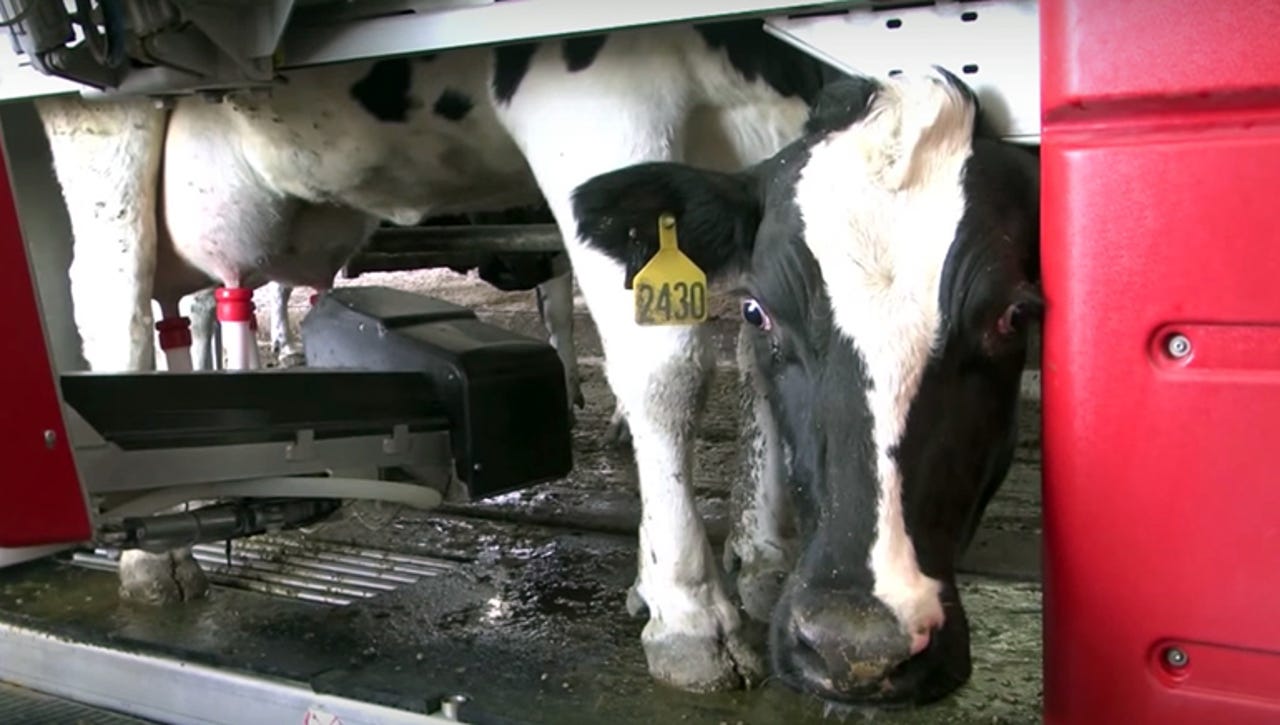How robots are filling worker shortages, replacing 'bad' jobs, and making work more rewarding


Across the globe, robots are showing up for work. They are crew members on cruises, teachers in classrooms, and even cow milkers on dairy farms.
So how do companies integrate robots into their business? Which jobs are lost, and which new ones are created? And how do robots affect the bottom line? Here's a look at four employers that are using robots to improve their enterprise.
Hemdale Farms
Nestled between Rochester and Syracuse in New York's Finger Lakes area, Hemdale Farms has been in operation since the 1950s. But even with the company's old-school roots, it's one of the most innovative around: almost a decade ago, it was one of the first to use robots for milking cows. Nineteen Lely Astronaut robots, made in Iowa, are now used daily to milk more than 1,000 cows at the Hemdale dairy -- the second largest robotic milking production in the US.
While there are hundreds of farms using robotic milking systems today, Hemdale Farms pioneered the practice a decade ago.
"I never intended or wanted to be an early adopter," said Dale Hemminger, owner of Hemdale Farms. "I was quite nervous that this would be an okay model for five or 10 years, but the industry would move in another direction."
Hemminger said he was in a unique spot. "I was almost 50 years old, and did not want to milk thousands, which is kind of the industry model now," he said.
Each robot, Hemminger said, milks about 60 cows, about three times a day. Some perform up to six times a day. The cows have IDs and transponders, and if they are 'eligible' to produce more milk, they will be fed sweet coated grain, which is high in energy and helps with lactation.
The robots, Hemminger said, have helped do a job that has been difficult to fill.
"The days of finding people that want to do this type of work that can be a little dirty, always strenuous," are over, he said.
Now, he said, the farm has openings for higher-level, more "self-directed" work, mostly involving working with the robots.
Aside from the actual hardware that makes milking possible, it's the software that Hemminger said is key to the robots' success. "The price of the robot seems steep, but you're getting all of this information gathering," he said. Thousands of data points are collected from the cows, and fed into the computer system to provide feedback on the health of the animals. "The computer prints out a list of five to 15 cows it's identified that are outside of parameters, and we know who might be coming down sick," said Hemminger.
It's the difference, he said, between having people come to the doctor for regular checkups versus landing in the emergency room when something is really wrong.
And on top of productivity and health, the cows are actually happier this way.
"Everyone that's put robots in tells you three months after they're in, that they can't believe how much friendlier their cows are," he said. The cows are less stressed milking this way, he said. And for Hemminger, it's all about the cows -- he doesn't want anyone interfering with their well-being.
"If you're having a bad day, just come tell me," he said. "You should go home."
Quiet Logistics
Bruce Welty was using Kiva robots for his warehouse at Quiet Logistics when the business started in 2009 -- three years before the robotics company was acquired by Amazon. After that happened, he created Locus Robotics, a mobile robotics business. "Now we have two companies," he said. "One that uses robots and one that makes robots."
Locus Robotics
The company, which has roughly 1,000 associates, wanted a competitive advantage in fulfilling orders for the e-commerce industry. It operates over 800,000 square feet of warehouse space, spread across three facilities. Currently, two of the facilities have Kiva robots, and one has Locus robots -- it plans to replace all Kiva robots in the next year -- and the robots manage between 20 percent and 80 percent of product fulfilment in each building.
Welty has seen a tremendous increase in productivity: The company is five times more productive than when it didn't use robots. He expects a payback on the investment in 18 months. "In the world of warehousing, any investment that has a payback in fewer than three years is considered a big win," he said.
In addition to the savings, Welty said that there are other key advantages to having robots: they create a better working environment, are easy to train, and create new tasks for employees.
SEE: Co-bots: Ford's experiment in robot-human collaboration where no one loses their job (TechRepublic)
"We do work with the employees to constantly discover new and novel ways to integrate the robots into their workflow," said Welty. "Not only are our employees happier and more productive, but we can give them more responsibility and ask them to do more interesting work."
Welty also claims his business has "not eliminated a single job." This is because the company is perpetually struggling to fill spots -- there are 500 job openings at the warehouses right now.
By using robots, Welty expects to "pass some of the productivity gains to our workers in the form of higher pay, which should mitigate some of the labor availability problem."
Fiege
Fiege, a logistics group in Germany, purchased 3 TORU "picking" robots, built by Munich startup Magazino, this month. The company, which has 10,500 employees and $1.4 billion in revenue, uses robots to help pick boxes of shoes from shelves for shipment.
"Robots will not replace our employees," said Julian Mester, online marketing manager at Fiege, "and there will be no eliminations because of our new digital colleagues." Instead, he said, they support human employees by lifting heavy or hard-to-reach packages. Also, Mester said, it can be difficult to find employees for these tasks in certain parts of Germany.
While the robots aren't always as efficient as employees -- Mester said a robot can pick 50 shoes an hour, while a human can pick 150 shoes -- they can help during peak times. Also, it's a move towards a "digitized, transparent warehouse," said Mester.
"We are the first logistics provider in Germany using robotics for applications in intralogistics, we will have to be patient," he said. "It is a long-term investment where we see a huge potential."
Dynamic Group
In Minneapolis, a small injection molding company bought three robots a year ago to help solve a worker shortage.
"To be honest, we have some bad jobs," said Joe McGillivray, CEO of Dynamic Group. By "bad," he means monotonous. They're jobs people don't typically stick with for long.
"In our business, there's a machine; you open and close the door. You take something out. You do that all day long, and it's really boring," said McGillivray. And in Minneapolis, a city with low unemployment, finding workers for these tasks has been difficult.
"Knowing that we would be able to take that bad job and turn it into a good job of learning how to program these robots and setting up these robots," said McGillivray, "that was why we started looking into using robotics."
Since they've acquired the three robots, Dynamic Group has quadrupled production of certain tasks, and hasn't laid anyone off.
McGillivray was surprised that his company could afford to purchase Universal Robots. "I assumed it was a six-figure-type deal to get into the type of robots," he said. But it turned out to be around $30,000 for "a robot that's easy to program and redeploy. That's why I jumped into it."
The company employs about 120 people--a mix of temporary and full-time employees. While it's considered a micro-sized molder, in terms of volume, "on the injection mold building side, we're one of the bigger shops in the country," he said.
Universal Robots
The robots are tasked with "overmolding," which McGillivray calls "a manual, very boring processes of clipping plastic or putting tubes on or off various posts, essentially."
"If we rely on a person to do that, we could basically run about four hours a day and make good parts," he said. "With a robot in place, we could run it 24/7. Also, when we were running without the robot, it took three to four people. With robots, it takes one."
Robots also equal job openings. Initially, McGillivray said, for engineers. They just hired an engineering manager, and need people to set up the robots to interact with the equipment. And since the production has increased so substantially, "high-paying jobs that take people who have a decent amount of training is what we're going to need," he said.
When they first implemented the robots, McGillivray was "concerned that our employees would be worried that we were going to take their jobs," he said. "We addressed it upfront--and what we found is that people became distracted by the robots."
But the distraction, he said, came from people being "entertained" by the robots. "I didn't expect that," he said. "Lots of people were excited to see that they didn't have to do that job anymore--the robot's taking care of it."
"To be completely honest, we still have a bunch of bad jobs," said McGillivray. "But as we are more successful at this, we'll be able to eliminate them."
Also see
- 6 ways the robot revolution will transform the future of work (TechRepublic)
- Automating the warehouse: Robots can increase productivity of existing labor force (ZDNet)
- Robots-as-a-service: New company introduces first 'goods-to-box' warehouse picking system (ZDNet)
- Why China is scooping up robots from Rethink Robotics to solve its manufacturing problem (TechRepublic)
- How will AI impact jobs? High-powered panel tackles the big question (TechRepublic)
- Future jobs: How humans and robots will complement each other (TechRepublic)